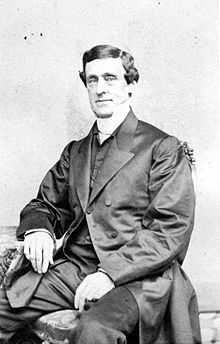Henry John Whitehouse

Henry John Whitehouse (August 19, 1803–August 10, 1874) was the second Episcopal bishop of Illinois.
Early life
Whitehouse was born in New York City, the son of John Whitehouse and Eliza Norman.[1] He graduated from Columbia University in 1821, and from the General Theological Seminary in 1824.[1] Whitehouse was ordained deacon in 1824, and was ordained priest in 1827.[1] After his ordination as priest, he became rector of Christ Church in Reading, Pennsylvania.[1] Two years later, he moved to become rector of St. Luke's Church in Rochester, New York, during which time he married his wife.[1] He remained there for fifteen years before moving to New York in 1844 to become rector of St. Thomas Church.
Bishop of Illinois
Whitehouse was elected coadjutor Bishop of Illinois in 1851.[1] He was the 55th bishop in the ECUSA, and was consecrated by Bishops Thomas Church Brownell, Alfred Lee, and Manton Eastburn.[2] Upon the death of Bishop Philander Chase, Whitehouse became bishop, but refused to take up his seat for nine years, until his salary demands were met.[3] The diocesan convention in 1860 charged him with dereliction of duty and generally condemned him.[3] During the American Civil War, Whitehouse displayed decidedly pro-Southern sympathies, further alienating his Illinois flock.[4]
Whitehouse identified with high church Anglicanism, and in 1868 he wrote of the real presence of Christ in the Eucharist.[5] Several of his clergy, led by Charles Edward Cheney, denounced the Anglo-Catholic idea, accusing Whitehouse of "unprotestantizing this Protestant Episcopal Church, corrupting her doctrine, debasing her worship, and over-turning her long-established rites, ceremonies, and usages."[5] Whitehouse had his revenge when, on hearing of Cheney's unauthorized omissions of certain liturgical phrases, he attempted to have Cheney deposed,[6] and by 1871, he was successful in having Cheney suspended from the ministry.[7] Cheney later became one of the original clergymen of the Reformed Episcopal Church.
While in England in 1867, Whitehouse delivered the opening sermon before the first Pan-Anglican conference at Lambeth Palace, by invitation of the Archbishop of Canterbury. He was among the first American bishops to advocate for a cathedral system in the Episcopal Church.
Henry John Whitehouse died in Chicago on August 10, 1874. He is buried in the Whitehouse family plot in Green-Wood Cemetery, Brooklyn, New York.
Family
Henry John Whitehouse married Evelina Harriet Bruen (1806-1864) on August 8, 1835, and they had five sons and one daughter: Henry Bruen Whitehouse (1838-1889), an attorney; Edward Norman Whitehouse (1839-1904), a career Naval officer whose duties included the office of Paymaster; Frederic Cope Whitehouse (1842-1911), also an attorney, but he engaged so ardently in his avocations of archaeology and Egyptology that his obituary in The New York Times referred to him as “the well-known Egyptologist”; William FitzHugh Whitehouse (1846-1909), yet another attorney; Francis Meredyth Whitehouse (1848-1938), the architect; and Louisa Bruen Whitehouse (Sheldon) (1850-1919). The middle names of some of these children, specifically, Meredyth, Cope, and FitzHugh, were surnames of women who had married into the Whitehouse family prior to 1800.
His great-grandson was Ambassador Charles S. Whitehouse. His great-great-grandson, Sheldon Whitehouse, is a Senator from Rhode Island.
Notes
References
- Batterson, Hermon Griswold (1878). A Sketch-book of the American Episcopate. Philadelphia: J. B. Lippencott & Co. Retrieved 2009-07-31.
- Guelzo, Allen C. (1994). For the Union of Evangelical Christendom: The Irony of the Reformed Episcopalians. Pennsylvania State University Press. ISBN 0-271-02732-0.
- The National Cyclopaedia of American Biography IX. New York: James T. White & Co. 1899. Retrieved 2009-07-29.
|